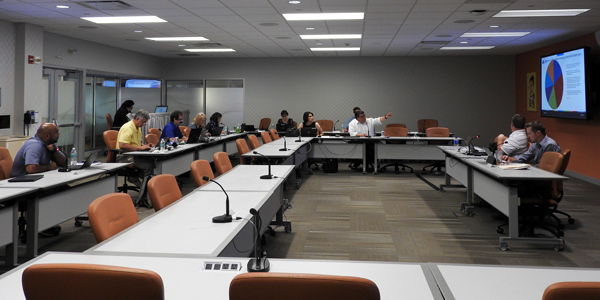By Rory D. Sweeney
VALLEY FORGE, Pa. — With the opening of PJM’s next long-term transmission proposal window looming less than four months away, it remains unclear whether the RTO will have new rules in place for evaluating and selecting market efficiency projects.
That would mean that any rule changes discussed by the Market Efficiency Process Enhancement Task Force since February that aren’t in place by the window’s Nov. 1 start will have to wait another two years for the Regional Transmission Expansion Plan’s next window.
After a three-hour meeting on Thursday, stakeholders remain at odds about how to move forward. A nonbinding poll showed stakeholders were unable to find at least 50% consensus on any of six solution proposals to address how PJM evaluates and chooses the discretionary transmission projects, which aren’t necessary for reliability but are meant to reduce congestion costs.
The Package A proposal received 49% approval, but stakeholders remained at odds over whether to exclude facility study agreements from the base case unless needed for reliability; whether to use a $10 million versus $20 million threshold on project re-evaluation criteria; and how to calculate energy benefits.
Given the intractability, PJM’s Brian Chmielewski, who oversees the task force, said the group should not forward all six proposals for consideration at the July 12 Planning Committee meeting, but instead attempt to sort through the polling results to assemble three new proposal packages. Stakeholders allowed Chmielewski to create the composite proposals but then balked at sending just those three to the committee.
LS Power’s Sharon Segner said the changes were significant enough for the task force to take another poll, which was supported by representatives from transmission owners Public Service Electric and Gas and American Electric Power. Chmielewski expressed concern about the further delay.
“If we do another poll, we lose the Nov. 1 effective date,” he explained, because there won’t be enough time to get it through the stakeholder endorsement process and receive FERC approval. “Slowing down a month means you miss another two years of new rules. … I think we should go to that [PC] meeting with the intent of having a first read” and take the committee’s input, he said.
Segner suggested adding the new rules to the upcoming window after it opens if FERC would approve such a move, but GT Power Group’s Dave Pratzon expressed concern that such late changes could disadvantage bidders.
Pauline Foley, PJM’s counsel, said she wasn’t “comfortable” with making a determination on whether PJM would be willing to ask FERC for a waiver to grant the approval in less than 60 days. PJM’s Asanga Perera added that other stakeholders might complain about the bidding rules potentially being changed halfway through the process. The window runs through February.
“I don’t think it’s just PJM’s call,” Perera said.
On Friday afternoon, RTO staff opened a poll on the three new proposals and gave stakeholders until noon on Wednesday to respond, giving staff enough time to compile and report the results at the PC.



